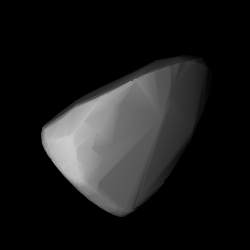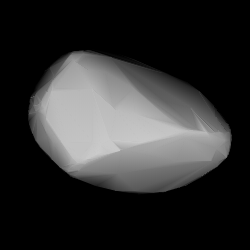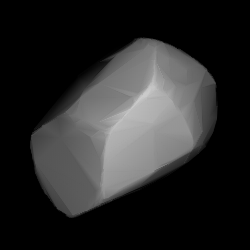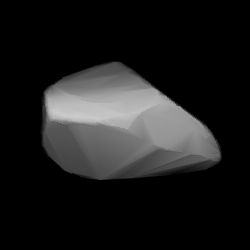Related Research Articles

1050 Meta, provisional designation 1925 RC, is a stony Eunomia asteroid from the central regions of the asteroid belt, approximately 10 kilometers in diameter. It was discovered on 14 September 1925, by German astronomer Karl Reinmuth at the Heidelberg Observatory in southwest Germany. The meaning of the asteroids's name is unknown. The presumably S-type asteroid has a rotation period of 6.14 hours and possibly an elongated shape.

1554 Yugoslavia, provisional designation 1940 RE, is a stony Eunomian asteroid from the middle region of the asteroid belt, approximately 16 kilometres (9.9 mi) in diameter. It was discovered by Serbian astronomer Milorad Protić at Belgrade Astronomical Observatory, Serbia, on 6 September 1940. It was named for the former country of Yugoslavia.

1118 Hanskya is a large background asteroid, approximately 77 kilometers in diameter, located in the outer regions of the asteroid belt. Discovered by Sergey Belyavsky and Nikolaj Ivanov in 1927, it was named after Russian astronomer Aleksey Hansky. The presumed dark C-type asteroid has a rotation period of 15.6 hours.

1132 Hollandia, provisional designation 1929 RB1, is a stony asteroid from the middle region of the asteroid belt, approximately 27 kilometers in diameter. It was discovered on 13 September 1929, by Dutch astronomer Hendrik van Gent at Leiden Southern Station, annex to the Johannesburg Observatory in South Africa. It was named for the region Holland in the Netherlands.

1160 Illyria, provisional designation 1929 RL, is a stony Maria asteroid from the central regions of the asteroid belt, approximately 13 kilometers in diameter. It was discovered on 9 September 1929, by German astronomer Karl Reinmuth at the Heidelberg Observatory in southwest Germany. The asteroid was named after the ancient region of Illyria, located on the Balkan Peninsula.
1213 Algeria is a carbonaceous asteroid from the outer region of the asteroid belt, approximately 32 kilometers in diameter. Discovered by Guy Reiss at Algiers Observatory in 1931, it was named after the North African country of Algeria.
1617 Alschmitt, provisional designation 1952 FB, is an assumed carbonaceous asteroid from in the outer parts of the main belt, approximately 30 kilometers in diameter. It was discovered on 20 March 1952, by French astronomer Louis Boyer at Algiers Observatory in Algeria, Northern Africa, and named after French astronomer Alfred Schmitt.

1333 Cevenola, provisional designation 1934 DA, is a binary Eunomian asteroid from the asteroid belt, approximately 15 kilometers in diameter. It was discovered on 20 February 1934, by French astronomer Odette Bancilhon at Algiers Observatory, Algeria in Northern Africa. It was named after the French mountain-range Cévennes, via the Occitan feminine adjective/demonym cevenòla.

1275 Cimbria is a Eunomia asteroid from the central regions of the asteroid belt, approximately 27 kilometers in diameter. It was discovered on 30 November 1932, by astronomer Karl Reinmuth at the Heidelberg-Königstuhl State Observatory in southern Germany. The asteroid was named after the Cimbri, an ancient Germanic tribe.
1295 Deflotte, provisional designation 1933 WD, is a carbonaceous asteroid from the outer regions of the asteroid belt, approximately 48 kilometers in diameter. It was discovered on 25 November 1933, by French astronomer Louis Boyer at the Algiers Observatory in Algeria, North Africa. The asteroid was named after the discoverer's nephew.
1384 Kniertje, provisional designation 1934 RX, is a dark Adeonian asteroid from the central regions of the asteroid belt, approximately 26 kilometers in diameter. It was discovered on 9 September 1934, by Dutch astronomer Hendrik van Gent at the Union Observatory in Johannesburg, South Africa. The asteroid was named after a character in the Dutch play Op Hoop van Zegen by Herman Heijermans.
2187 La Silla, provisionally designated 1976 UH, is a stony Eunomia asteroid from the middle region of the asteroid belt, approximately 12 kilometers in diameter.
1303 Luthera, provisional designation 1928 FP, is a dark asteroid and the parent body of the Luthera family, located in the outermost regions of the asteroid belt. It measures approximately 90 kilometers in diameter. The asteroid was discovered on 16 March 1928, by astronomer Friedrich Schwassmann at the Bergedorf Observatory in Hamburg, Germany, and later named after German astronomer Robert Luther.
1300 Marcelle, provisional designation 1934 CL, is a carbonaceous asteroid from the middle region of the asteroid belt, approximately 30 kilometers in diameter. It was discovered on 10 February 1934, by French astronomer Guy Reiss at the North African Algiers Observatory in Algeria.
1416 Renauxa, provisional designation 1937 EC, is an Eon asteroid from the outer regions of the asteroid belt, approximately 29 kilometers in diameter. It was discovered on 4 March 1937, by French astronomer Louis Boyer at the Algiers Observatory in Algeria, North Africa. It was named after Joseph Renaux, an astronomer at the discovering observatory.

1364 Safara, incorrectly designated 1935 VB, is an Eoan asteroid from the outer regions of the asteroid belt, approximately 25 kilometers in diameter. It was discovered on 18 November 1935, by French astronomer Louis Boyer at the Algiers Observatory in Algeria, North Africa. The asteroid should have been designated 1935 WB, as the letter "V" only covers discoveries made during 1–15 November. It was named after André Safar, presumably an acquaintance of the discoverer from Algiers.
2308 Schilt, provisional designation 1967 JM, is a stony Eunomia asteroid from the asteroid belt, approximately 17 kilometers in diameter. It was discovered on 6 May 1967, by Argentine astronomer Carlos Cesco together with American astronomer Arnold Klemola at the Yale–Columbia Southern Station at Leoncito Astronomical Complex in Argentina.
1405 Sibelius, provisional designation 1936 RE, is a stony Florian asteroid from the inner regions of the asteroid belt, approximately 8 kilometers in diameter. It was discovered on 12 September 1936, by Finnish astronomer Yrjö Väisälä at Turku Observatory in Southwest Finland. The asteroid was named after composer Jean Sibelius.

1301 Yvonne is a carbonaceous background asteroid from the background population of the intermediate asteroid belt, approximately 21 kilometers in diameter. It was discovered on 7 March 1934, by French astronomer Louis Boyer at the Algiers Observatory in North Africa. The asteroid was named for the discoverer's sister, Yvonne Boyer
1296 Andrée, provisional designation 1933 WE, is a stony Nysian asteroid from the inner regions of the asteroid belt, approximately 25 kilometers in diameter. It was discovered on 25 November 1933, by French astronomer Louis Boyer at the North African Algiers Observatory, Algeria, and named after the discoverer's niece.
References
- 1 2 3 4 5 6 7 8 9 "JPL Small-Body Database Browser: 1215 Boyer (1932 BA)" (2017-07-05 last obs.). Jet Propulsion Laboratory . Retrieved 17 August 2017.
- 1 2 3 Schmadel, Lutz D. (2007). "(1215) Boyer". Dictionary of Minor Planet Names – (1215) Boyer. Springer Berlin Heidelberg. p. 101. doi:10.1007/978-3-540-29925-7_1216. ISBN 978-3-540-00238-3.
- 1 2 3 4 5 6 "LCDB Data for (1215) Boyer". Asteroid Lightcurve Database (LCDB). Retrieved 17 August 2017.
- 1 2 3 4 Kim, M.-J.; Choi, Y.-J.; Moon, H.-K.; Byun, Y.-I.; Brosch, N.; Kaplan, M.; et al. (March 2014). "Rotational Properties of the Maria Asteroid Family". The Astronomical Journal. 147 (3): 15. arXiv: 1311.5318 . Bibcode:2014AJ....147...56K. doi:10.1088/0004-6256/147/3/56.
- 1 2 Masiero, Joseph R.; Grav, T.; Mainzer, A. K.; Nugent, C. R.; Bauer, J. M.; Stevenson, R.; et al. (August 2014). "Main-belt Asteroids with WISE/NEOWISE: Near-infrared Albedos". The Astrophysical Journal. 791 (2): 11. arXiv: 1406.6645 . Bibcode:2014ApJ...791..121M. doi:10.1088/0004-637X/791/2/121 . Retrieved 17 August 2017.
- 1 2 3 4 Mainzer, A.; Grav, T.; Masiero, J.; Hand, E.; Bauer, J.; Tholen, D.; et al. (November 2011). "NEOWISE Studies of Spectrophotometrically Classified Asteroids: Preliminary Results". The Astrophysical Journal. 741 (2): 25. arXiv: 1109.6407 . Bibcode:2011ApJ...741...90M. doi:10.1088/0004-637X/741/2/90.
- 1 2 3 4 Usui, Fumihiko; Kuroda, Daisuke; Müller, Thomas G.; Hasegawa, Sunao; Ishiguro, Masateru; Ootsubo, Takafumi; et al. (October 2011). "Asteroid Catalog Using Akari: AKARI/IRC Mid-Infrared Asteroid Survey". Publications of the Astronomical Society of Japan. 63 (5): 1117–1138. Bibcode:2011PASJ...63.1117U. doi:10.1093/pasj/63.5.1117. (online, AcuA catalog p. 153)
- 1 2 3 4 Nugent, C. R.; Mainzer, A.; Masiero, J.; Bauer, J.; Cutri, R. M.; Grav, T.; et al. (December 2015). "NEOWISE Reactivation Mission Year One: Preliminary Asteroid Diameters and Albedos". The Astrophysical Journal. 814 (2): 13. arXiv: 1509.02522 . Bibcode:2015ApJ...814..117N. doi:10.1088/0004-637X/814/2/117 . Retrieved 17 August 2017.
- 1 2 3 4 Masiero, Joseph R.; Mainzer, A. K.; Grav, T.; Bauer, J. M.; Cutri, R. M.; Nugent, C.; et al. (November 2012). "Preliminary Analysis of WISE/NEOWISE 3-Band Cryogenic and Post-cryogenic Observations of Main Belt Asteroids". The Astrophysical Journal Letters. 759 (1): 5. arXiv: 1209.5794 . Bibcode:2012ApJ...759L...8M. doi:10.1088/2041-8205/759/1/L8 . Retrieved 17 August 2017.
- ↑ Veres, Peter; Jedicke, Robert; Fitzsimmons, Alan; Denneau, Larry; Granvik, Mikael; Bolin, Bryce; et al. (November 2015). "Absolute magnitudes and slope parameters for 250,000 asteroids observed by Pan-STARRS PS1 - Preliminary results". Icarus. 261: 34–47. arXiv: 1506.00762 . Bibcode:2015Icar..261...34V. doi:10.1016/j.icarus.2015.08.007 . Retrieved 17 August 2017.
- 1 2 "1215 Boyer (1932 BA)". Minor Planet Center. Retrieved 17 August 2017.
- ↑ Schmadel, Lutz D. "Appendix – Publication Dates of the MPCs". Dictionary of Minor Planet Names – Addendum to Fifth Edition (2006–2008). Springer Berlin Heidelberg. p. 221. doi:10.1007/978-3-642-01965-4. ISBN 978-3-642-01964-7.